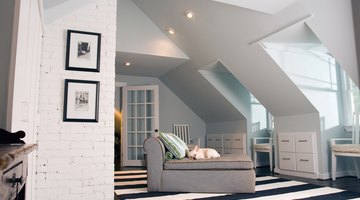How to Use Pulleys to Make a Ceiling Bed
A ceiling bed is an innovative way to create additional usable space while at the same time accentuating the design elements of the traditional bed. With just a few decorative ropes or cables and moderate skills you can accomplish this unusual bedroom style.

It is especially appealing when you have a vaulted or higher ceiling available. Most of all, this is an extremely inexpensive home project.
Things You Will Need
- Plumb bob
- Pencil
- Stud finder
- Hammer
- 7 medium-length finish nails
- 50 foot string line
- Electric drill
- 1/4-inch wood bit
- 7 3/8-inch eye hook lag screws, 4 inches long
- Long screwdriver
- 5 single pulleys sized to accommodate decorative rope
- Decorative rope at least 10 percent longer than needed length
- 2 decorative steel closed rings
-
Position the bed within the room at its resting height so that all four corners are directly under a secure ceiling joist. If one or more corners is not directly under such a joist, you will need to provide solid blocking above the corner. Use a plumb bob above each corner to indicate with a pencil mark the placement desired on the ceiling, then use the stud finder to indicate the presence of ceiling joists or rafters.
-
Drive a small nail in the ceiling at each corner with a hammer. Tie the string line to one of the nails. Pull the remaining string around each of the other nails, and cross the diagonals to create an "X" pattern. Where the strings intersect in the middle, drive one more nail. Use the stud finder once more to indicate the presence of a solid blocking member directly at this center point. Ensure the presence of a solid member at that point.
-
Drill a pilot hole at each nail location with the drill and bit. Use the screwdriver inserted in the eye hook to twist in a closed lag screw at each pilot hole. Make sure all four of these lags are secure. Hang a pulley from each corner.
-
Choose on which side of the headboard area you want to locate the draw string. From that side, install one lag screw eye hook at the desired height on the side wall, convenient for you to reach. Directly above that eye hook, install another eye hook in the ceiling. Make sure these lag screws are also in a secure framing member.
-
Install a pulley at each corner eye hook and one at the ceiling location above the wall eye hook on the side of the bed.
-
At each corner of the bed, securely fasten the decorative rope and guide it through the pulley directly above the corner. Continue guiding the rope through the center eye hook, draping it loosely approximately 6 inches. Each of these ropes should be exactly the same length. Tie each rope to the decorative steel closed ring.
-
Tie an additional length of rope to that center closed ring and guide it through the ceiling pulley above the side wall lag screw. Continue the rope down through the side wall lag screw. Tie that end to another decorative closed ring, leaving little or no slack in that line. This will be the resting position of the bed.
-
On the side wall and behind the rope, secure the boat-style tie down device to the wall. When you desire to raise the bed, this will become the location to tie the raised bed at your desired heights.
-
Test the system by pulling on the side rope to raise the bed. Repeat several times making sure that each time it returns to the level position. Adjust the tied ropes as necessary.
Tip
To eliminate drifting as the bed hangs, use two metal or wood straps, one at each corner of the headboard side. Locate these straps so that they are not visible, and attach the straps to the side wall.
Warning
Ensure that each lag screw eye hook is firmly secured into a wood substructure. Do not overload the bed beyond the capacity of the ropes.
The Drip Cap
- A ceiling bed is an innovative way to create additional usable space while at the same time accentuating the design elements of the traditional bed.
- Tie the string line to one of the nails.
- Pull the remaining string around each of the other nails, and cross the diagonals to create an "X" pattern.
- Ensure the presence of a solid member at that point.
- Make sure all four of these lags are secure.
- At each corner of the bed, securely fasten the decorative rope and guide it through the pulley directly above the corner.
- When you desire to raise the bed, this will become the location to tie the raised bed at your desired heights.
References
Writer Bio
Phil Mariage has produced and hosted his own public radio program for more than nine years.He holds a Bachelor of Arts in philosophy from Olivet Nazarene University and has worked in construction management since 1971. He was elected to three terms on his local school board. His writings appear at Blogspot.com.
Photo Credits
- Jupiterimages/Photos.com/Getty Images
- Jupiterimages/Photos.com/Getty Images
More Articles



